
BENNU’S DUST HOLDS LIFE’S BUILDING BLOCKS
Introduction:
NASA’s OSIRIS-REx (Origins Spectral Interpretation Resource Identification and Security-Regolith Explorer) mission marked a milestone with the return to Earth of a sample taken from the asteroid Bennu, located some 63 million kilometres away (Fig. 1). Preliminary analysis of the collected material revealed the presence of fundamental organic compounds, suggesting that Bennu may be a fragment of an ancient planetary body that, in the distant past, hosted liquid water. This extraordinary result opens up new perspectives on understanding the origins of life in our solar system!

Fig.1(Left)One Rehearsal Away from Touching Asteroid Bennu- NASA’s OSIRIS-REx, (right) Asteroid Bennu, Credits NASA/Goddard/University of Arizona.
OSIRIS-REx exploring Asteroid Bennu:
NASA’s OSIRIS-REx mission, which was launched on September 8, 2016, reached the asteroid Bennu in December 2018 and subsequently started mapping the asteroid surface in high resolution. On October 20, 2020, the spacecraft effectively gathered samples using its innovative Touch-and-Go Sample Acquisition Mechanism (TAGSAM) and on September 24, 2023, the sample capsule returned to Earth‘s atmosphere and landed safely in the Utah Test and Training Area, where it was later retrieved for ongoing analysis (Fig. 2).
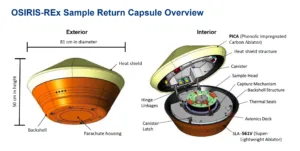
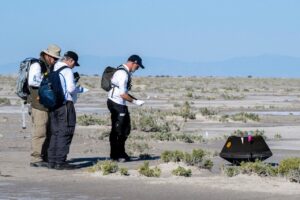
Fig.2 (Left) OSIRIS-REx Sample Return Capsule Overview, Credits Lockheed Martin Space (right) OSIRIS-REx Sample Capsule Safely Touches Down with NASA’s First-Ever Asteroid Sample, Credits Nasa/Keegan Barber.
Scientists had discovered 14 of the 20 amino acids that are needed for life on Earth in the samples. All five nucleotides needed for DNA and RNA, which are strong pointers to the fact that the very basic building blocks of life were present on Bennu‘s surface, were discovered(Fig.3). The mineral composition of the asteroid also produced evidence of saltwater evaporation, which resulted in the indication that Bennu was probably derived from a water-rich source.
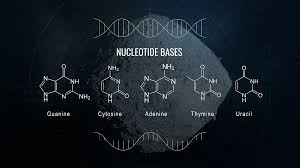
Fig.3 The five nucleotides needed for DNA and RNA, Credits Nasa
Moreover, the samples were replete with carbon, nitrogen, and complex organic molecules—it is important to note that this does not imply the existence of life. However, the fundamental components required for life’s emergence have been identified! These results confirm the theory that Bennu could be a remnant of an ancient ocean world. They also provide evidence for the theory of panspermia, which suggests that asteroids like Bennu could have been the agents that delivered some of the material that gave rise to life on Earth. Looking ahead, the OSIRIS-REx mission is not yet complete. It is now traveling to another asteroid, Apophis, to continue investigating how carbonaceous asteroids could have spread organic molecules throughout the solar system.
What the chemical analysis reveals:
Analyses conducted on the samples gathered from the asteroid Bennu revealed a fascinating range of chemical compounds of special interest from both organic chemistry and geochemistry points of view. The most prominent discoveries consisted of the presence of an evaporitic mineral succession comprising mainly sodium carbonates (Na₂CO₃), sodium and magnesium phosphates (NaMg(PO₄)-9H₂O), sodium sulphates (Na₂SO₄), halides such as sodium fluoride (NaF) and sodium chloride (NaCl), and complex carbonates such as dolomite ((Mg,Ca)CO₃) and magnesite (MgCO₃). These minerals were precipitated from sodium-rich salt solutions through precipitation processes, likely due to an ancient water-rock interaction in the ancestral body of Bennu.
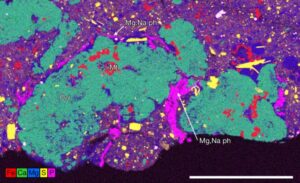
Fig.4 Shows veins of sodium and magnesium phosphates associated with phyllosilicates, highlighting their formation due to the evaporation of saline fluids on Bennu, Mg,Na phosphate occurs with Mg phyllosilicates largely free of micron-sized sulfide inclusions. The Mg, Na phosphate–Mg phyllosilicate veins rim large dolomite (Dol) grains that include magnetite (multielement Kα X-ray map; sample no. OREX-803085-100). Scale bar, 200 µm, Credits Nature.
The progressive concentration of the salt after evaporation resulted in the sequential deposition of various mineral phases. Particularly, the presence of sodium and magnesium phosphates confirms a regime controlled by apatite-carbonate equilibrium as in terrestrial evaporitic basins (Fig. 4& 5). Moreover, the analysis revealed the presence of nucleobases, which are the five simple compounds making up terrestrial nucleic acids. This leaves fascinating potential for establishing prebiotic molecules in Bennu, with phosphates and salts also said to have catalyzed chemical activity at the foundations of nucleotide synthesis. Chemical conditions observed, characterized by alkaline liquids with present clay minerals (phyllosilicates), would suggest that Bennu may have been a promising environment for ancient chemical evolution. Finally, the mineral similarity of Bennu to other bodies such as Ceres and Enceladus indicates that hydrothermal activity and water-rock interaction were widespread in the early Solar System. Additionally, Bennu contains sodium-rich evaporites, which are absent in normal carbonaceous meteorites, suggesting its parent body experienced extensive geochemical evolution in liquid-water-rich environments before fragmenting and forming the present asteroid.
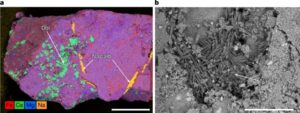
Fig.5 Illustrate the deposition of sodium carbonates in a vein (4a) and their needle-like structure (4b), showcasing their formation and evolution in Bennu samples: a, Na carbonates (orange) underlie a flat surface, which is itself overlain by dolomite-bearing (teal), phyllosilicate-rich (purple) host rock containing magnetite and sulfide (red) (multielement Kα X-ray map; sample no. OREX-803088-0). b, Na carbonate, occuring as needles of less than 1-µm wide and 5–10-µm long, in a vein or sheet that underlies a clast (backscattered electron (BSE) image; sample no. OREX-803088-0). Scale bars, 500 µm (a) and 20 µm (b)., Credits Nature.
Bennu and Lake Searles – Salty Link to Life:
A fascinating connection could be found between the asteroid Bennu and a special place on Earth: Lake Searles in California (Fig. 6). By analysing samples from Bennu, scientists have discovered tiny crystals of Trona and other evaporitic minerals, the same ones that form in salt lakes on Earth when water evaporates and leaves behind minerals. Lake Searles is one such case, known precisely for its deposits of Trona, a mineral that forms from alkaline brines and is one of the primary sources of sodium bicarbonate. The existence of these minerals on the asteroid could suggest that sodium-rich pockets of water were also present on the asteroid in the past, allowing perfect chemistry for chemical reactions to create complex compounds. This discovery not only links an ancient space pebble to a familiar Earth environment, but also supports the theory that salt brines may have played a crucial role in the evolution of life, at least here on our planet, but probably throughout our solar system.
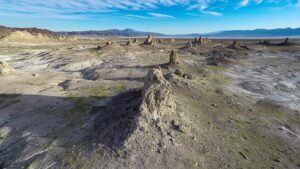
Fig. 6 When water levels were high at Searles Lake, the lake produced iconic evaporite formations—tall spires of calcium carbonate (tufa) known as the Trona Pinnacles, Credits Nasa.
Bennu’s Surprising Ammonia and Ancient Origins:
In addition to organic molecules, Bennu’s samples contain a surprising amount of ammonia. In space, ammonia is a key ingredient in chemical reactions that lead to complex organics. It is commonly used as an agricultural fertilizer on Earth, but it evaporates quickly at room temperature. However, ammonia remains stable in the solar system’s cold outer regions. Bennu is too close to the Sun to retain pure ammonia, meaning its material must have formed long ago in a much colder environment. Thanks to OSIRIS-REx, we can now piece together a likely origin story for the asteroid. Four and a half billion years ago, a rocky, metallic, and icy world took shape at the outer edges of the young solar system. Radioactive decay warmed its interior, melting some of the ice and creating pockets of mineral-rich water. In these pockets, ammonia and formaldehyde reacted to form organic molecules. When the water dried up, the dissolved minerals crystallized, leaving bright veins in the rock. Over time, this world drifted closer to the sun until a violent collision shattered it into pieces. Bennu formed from the debris and slowly moved inward, settling into an orbit near Earth, where OSIRIS-REx could finally reach it.
Conclusions:
An unparalleled window into the asteroid Bennu’s geological and chemical past has been made possible by the OSIRIS-REx mission, illuminating the basic components that might have played a role in the emergence of life. Ammonia-rich chemicals, evaporitic minerals, nucleotides, and amino acids all indicate that liquid water and intricate chemical processes necessary for prebiotic chemistry were once present in Bennu’s parent body. The notion of panspermia is supported by these observations, which also raise the possibility that asteroids like Bennu were essential in bringing organic materials to Earth and other planetary bodies. Further evidence that water-rock interactions were common in the early Solar System comes from Bennu’s resemblance to terrestrial salt lakes and other celestial bodies like Ceres and Enceladus. OSIRIS-REx is still traveling to Apophis, and the mission’s aim is to deepen our understanding of the dynamics of near-Earth asteroids and their role in planetary evolution.
References:
[1]https://science.nasa.gov/mission/osiris-rex/
[2]https://www.nature.com/articles/s41586-024-08495-6
Author: Lorenzo I & Aakaash A




